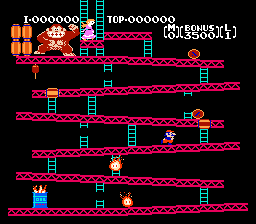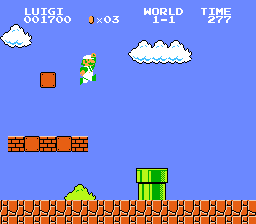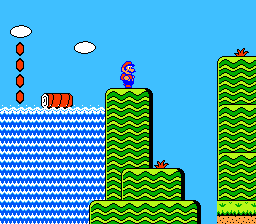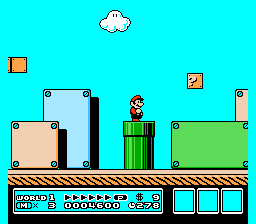Classic Games Emulation | News | Systems | Emulation | Emulators | Games | Links
Mario: The Great One
 Few today would question the prominence of Mario, or for that matter his brother Luigi, as a video game star. Mario has been with us now for a decade and a half now, and his popularity has hardly waned, as evidenced by the popularity of his latest release, Mario 64 for the Nintendo 64. Next to Mario, the fame of Sonic the Hedgehog, Lara Croft, the DOOM Guy, and even Pac Man (not to mention Mario's ancient nemesis himself, Mr. Kong) are but passing fads. But let us now consider his rise to fame.
Few today would question the prominence of Mario, or for that matter his brother Luigi, as a video game star. Mario has been with us now for a decade and a half now, and his popularity has hardly waned, as evidenced by the popularity of his latest release, Mario 64 for the Nintendo 64. Next to Mario, the fame of Sonic the Hedgehog, Lara Croft, the DOOM Guy, and even Pac Man (not to mention Mario's ancient nemesis himself, Mr. Kong) are but passing fads. But let us now consider his rise to fame.
 Mario began his career as a supporting actor for another video game great - Donkey Kong. They starred in an arcade game which cast Donkey Kong as the villain from whom Mario must rescue the girl (as is the case with any heart throb, Mario's heroines are remembered usually as mere props for the true star). At this time we knew only that Mario was a construction worker - his vocation as a plumber would be revealed later. Mario here has yet to develop many of his later abilities: For example, he can only fall a short distance before he, er, perishes; in later games Mario showed himself to be capable of performing far more challenging jumps (jumps impossible for most mere mortals) without injury. But Mario is still recognizable, even if he is under the shadow of Donkey Kong. Unfortunately for Mr. Kong, Mario soon show more brightly than he, and it was not for another decade that he reappeared at full strength in the masterpiece Donkey Kong Kountry. (There were intervening appearances, but they are not of the same note as Mario's successes, certainly.)
Mario began his career as a supporting actor for another video game great - Donkey Kong. They starred in an arcade game which cast Donkey Kong as the villain from whom Mario must rescue the girl (as is the case with any heart throb, Mario's heroines are remembered usually as mere props for the true star). At this time we knew only that Mario was a construction worker - his vocation as a plumber would be revealed later. Mario here has yet to develop many of his later abilities: For example, he can only fall a short distance before he, er, perishes; in later games Mario showed himself to be capable of performing far more challenging jumps (jumps impossible for most mere mortals) without injury. But Mario is still recognizable, even if he is under the shadow of Donkey Kong. Unfortunately for Mr. Kong, Mario soon show more brightly than he, and it was not for another decade that he reappeared at full strength in the masterpiece Donkey Kong Kountry. (There were intervening appearances, but they are not of the same note as Mario's successes, certainly.)
Mario next appeared, along with his brother Luigi, in Mario Bros. Luigi was introduced for the reason of allowing two players to compete simultaneously. Hence, another character must be introduced, or Mario must remain an anonymous and faceless clone. Mario Bros. was also Mario's first appearance as a plumber, though it was his only game to show him on the job. After two apperances, Mario's name was beginning to stick the same way Pitfall Harry's did: recognizable, but only marginally significant. His next appearance changed that.
 Super Mario Bros. was a smashing success, and, naturally, the game that forever burned Mario's name in to the minds (and thumbs) of people everywhere. Mario and Luigi were the only sane things in this fantastic and surreal (if invigorating) quest to rescue the Princess (this time a not quite so forgettable heroine) from Bowser. Its weirdness aside, Super Mario Bros. was Nintendo's flagship game for the NES in 1985, and it quickly gained popularity, further bolstering the success of its already recognizable stars. Super Mario Bros. was what made Mario what we know him as today. It showed that he could take falls from clouds and survive, that he could jump ten stories or so at a time, and that he had the ability to swim.
Super Mario Bros. was a smashing success, and, naturally, the game that forever burned Mario's name in to the minds (and thumbs) of people everywhere. Mario and Luigi were the only sane things in this fantastic and surreal (if invigorating) quest to rescue the Princess (this time a not quite so forgettable heroine) from Bowser. Its weirdness aside, Super Mario Bros. was Nintendo's flagship game for the NES in 1985, and it quickly gained popularity, further bolstering the success of its already recognizable stars. Super Mario Bros. was what made Mario what we know him as today. It showed that he could take falls from clouds and survive, that he could jump ten stories or so at a time, and that he had the ability to swim.
If Super Mario Bros. was odd, then there is no word to describe Super Mario Bros. 2, so once again we must overlook its bizarreness. Here we discover for the first (and still only time) that Luigi is taller than Mario and that he has an annoying habit of kicking his feet as he jumps. SMB2 was also the first appearance of the Princess in a starring role, along with a mushroom whom nobody really cares about anyway. I should note here that SMB2 as it appeared in the US was not the real Super Mario Bros. 2, which never left the Japanese shore. It is instead the modification of an unrelated game to give it a Mario fasad. Of course, SMB2 also used different gameplay elements than the other Super Mario Bros. games, e.g., Mario did not kill enemies by jumping on them or throwing fireballs at them, but picking them up and heaving them to their very destruction. These differences, put succinctly, screwed everything up. Nevertheless, Super Mario Bros. 2 further cemented Mario's fame and success.
 |  |
| Super Mario Bros. 2 | Super Mario Bros. 3 |
Super Mario Bros. 3 brought Mario closer what he had been in SMB1. Once again he was stomping enemies and breaking bricks with his head; the real Mario had returned. However SMB3 also introduced some new weapons into Mario and Luigi's arsenal. They could now become Raccoon Mario (or Luigi) and fly, or Frog Mario to swim better, among other things. Whereas such things could have negatively affected gameplay, they actually enhanced it (although after the second game in the series, any thing closer to the original was a welcome change). Super Mario Bros. 3, a wildly popular game, showed that Mario wasn't dead yet, and paved the way for a forceful return when the Super Nintendo was released.
Super Mario World, once again Nintendo's flagship product on its new console the SNES, took most of its elements from the earlier Mario games, especially (of course) SMB3. It used the Super Mario 1 and 3 run, jump, and squish model, and pitted Mario against various Bowser relatives who hid out in castles. It simplified Mario once again, only allowing him the ability to throw fireballs and fly (although they took away the mondo rad raccoon tail and ears and gave him a more mundane cape); the Frog suits and such were gone. It also introduced an important Mario ally, Yoshi the dinosaur whom Mario could ride like a horse. It is interesting to note that Yoshi has been one of the biggest video game stars since his introduction; but he, unlike Mario, was unable to pass in popularity the one who gave him his first shot at stardom. Super Mario World was Mario's last great appearance, though there always have been many lesser ones; Mario has had countless cameos, and, of course, there is also the Super Mario Land series for Gameboy. These however more capitalized on Mario's fame than advanced it.
 |  |  | ||
| Donkey Kong | ||||
| Mario Bros. | ||||
| Atari 2600 Versions | Donkey Kong | Super Mario Bros. | Super Mario Bros. 2 | Super Mario Bros. 3 |
![]() Mario is certainly today the most recognizable video game star, though his fame is probably less today than it was in the eighties (Lara Croft seems to overshadow everyone for one thing). Pac Man was the first video game character to build name recognition, but he was not able to sustain it the way Mario was. Sonic always tried to be as famous as Mario, but the clout of Nintendo and the more general appeal of the Mario games simpler gameplay kept his popularity always second to Mario's. Lara Croft was the first 3D game star to gain Mario's kind of name recognition (sorry Duke) courtesy of Tomb Raider's success (and the size and shape of Ms. Croft's bustline), but she is still too new to have proved as successful as Mario. (Far too few gamers know who Kyle Katarn, another important 3D game star, is, but this is not a forum for discussing the superiority of Dark Forces, or so I keep trying to convince myself...) And so, I declare Mario to be the greatest and most recognizable video game star to date. Long live the King!
Mario is certainly today the most recognizable video game star, though his fame is probably less today than it was in the eighties (Lara Croft seems to overshadow everyone for one thing). Pac Man was the first video game character to build name recognition, but he was not able to sustain it the way Mario was. Sonic always tried to be as famous as Mario, but the clout of Nintendo and the more general appeal of the Mario games simpler gameplay kept his popularity always second to Mario's. Lara Croft was the first 3D game star to gain Mario's kind of name recognition (sorry Duke) courtesy of Tomb Raider's success (and the size and shape of Ms. Croft's bustline), but she is still too new to have proved as successful as Mario. (Far too few gamers know who Kyle Katarn, another important 3D game star, is, but this is not a forum for discussing the superiority of Dark Forces, or so I keep trying to convince myself...) And so, I declare Mario to be the greatest and most recognizable video game star to date. Long live the King! ![]()
About CGE (including contact information)
Created June 1, 1998.
Last updated October 28, 1998.